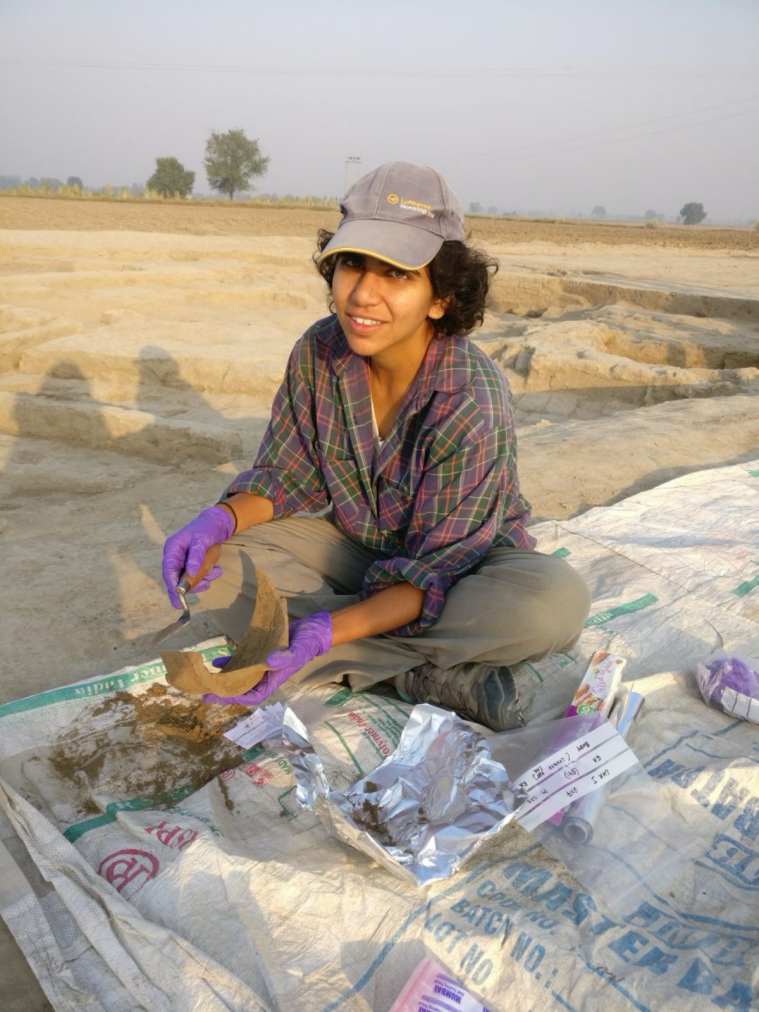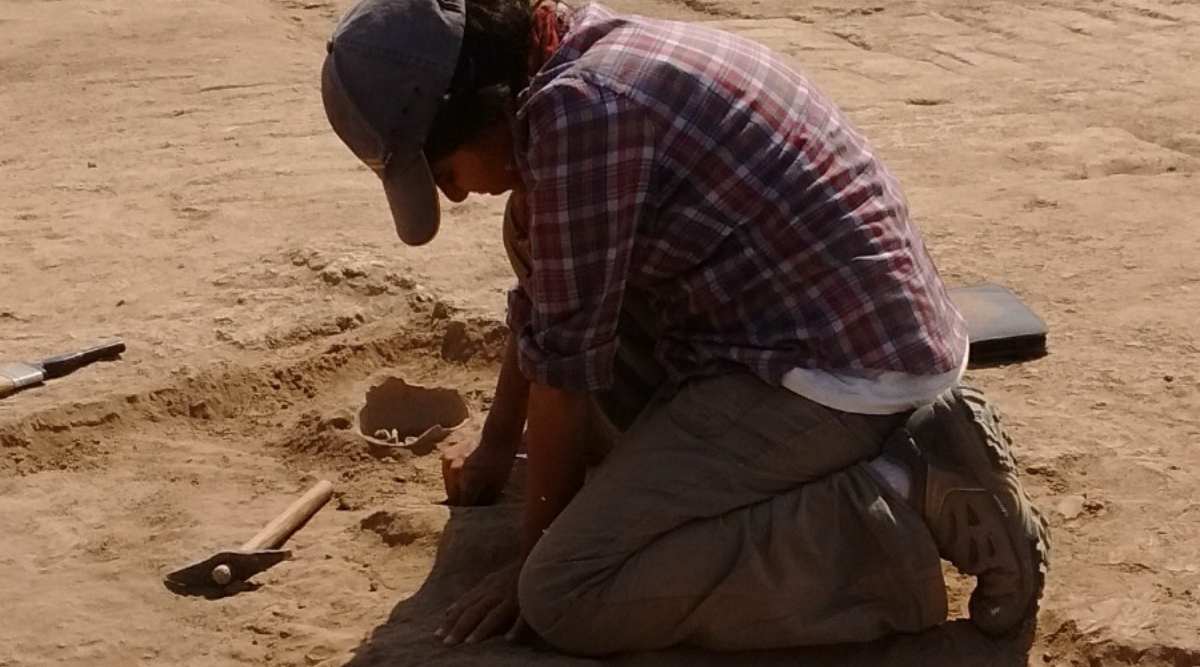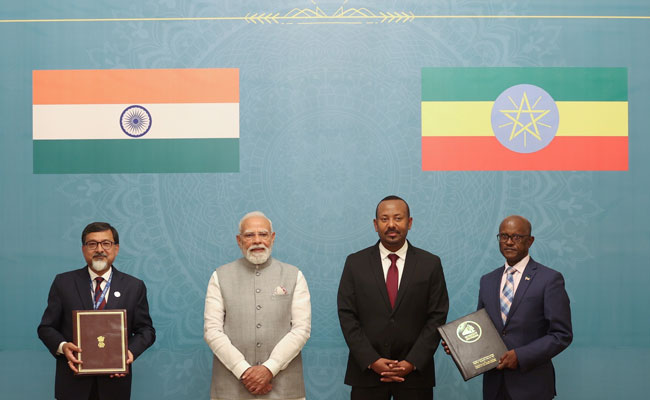This report was first published in indianexpress.com and has been posted here without any alterations or editing. To read the original report, CLICK HERE
The diet of the people of Indus Valley civilisation had a dominance of meat, including extensive eating of beef, finds a new study published on Wednesday in the ‘Journal of Archaeological Science’.
The study, titled “Lipid residues in pottery from the Indus Civilisation in northwest India” and led by Akshyeta Suryanarayan as a part of her PhD thesis at the University of Cambridge, looks at the food habit of the people of that era on the basis of lipid residue analysis found in pottery from Harappan sites in Haryana.
It finds dominance of animal products such as meat of pigs, cattle, buffalo, sheep and goat, as well as dairy products, used in ancient ceramic vessels from rural and urban settlements of Indus Valley civilisation in northwest India – in present-day Haryana and Uttar Pradesh.

A study, led by Akshyeta Suryanarayan, as a part of her PhD thesis at the University of Cambridge, looks at the food habit of the people of that era on the basis of lipid residue analysis found in pottery from Harappan sites in Haryana.
The study has been co-authored by former vice-chancellor of Pune’s Deccan College and renowned archaeologist Prof Vasant Shinde and Prof Ravindra N Singh of BHU, as well as with Miriam Cubas, Oliver E. Craig, Carl P. Heron, Tamsin C. O Connell, Cameron A. Petrie of Cambridge University.
How the study was conducted
Indus Valley civilisation was spread across large parts of modern Pakistan, northwest and western India and Afghanistan. The scope of this study concentrates on five villages – Alamgirpur (Meerut, UP), two in Masudpur (Hisar, Haryana), Lohari Ragho (Hisar), Khanak (Bhiwani, Haryana) – as well as Farmana town (in Rohtak district) and Rakhigarhi city (Hisar). Analysis was conducted on 172 pottery fragments recovered from the sites. Ceramic lipid residue analysis provides a powerful means by which foodways of populations can be examined and has been used in a range of archaeological contexts around the world to extract and identify foodstuff within ancient vessels, Suryanarayan said. The study says: “Ceramics are one of the most ubiquitous artefacts recovered during archaeological excavations of proto- and historic South Asian sites. Between 2600–1900 BC, five Indus Civilisation settlements developed into sizable cities, with a range of other medium-sized urban settlements, small settlements with specialised craft production and fortifications as well as rural settlements.” The study also talks of a diversity of plant products and regional variation in cropping practices. Both summer and winter-based cropping was practiced. Evidence of barley, wheat, rice, different varieties of millets, a range of winter and summer pulses, oilseed and fruit and vegetables, including brinjal, cucumber, grapes, date palm were grown and consumed.
Suryanarayan told The Indian Express that while there have been many studies on the food habit in Indus Valley civilisation before, these papers primarily focused on crops grown then. Suryanarayan’s PhD was on “What’s cooking in the Indus Civilisation? Investigating Indus food through lipid residue analysis.’’
“Out of domestic animals, cattle/buffalo are the most abundant, averaging between 50% and 60% of the animal bones found, with sheep/goat accounting for 10% animal remains. The high proportions of cattle bones may suggest a cultural preference for beef consumption across Indus populations, supplemented by consumption of mutton/lamb,’’ says the study.
It says that at Harappa, 90% of the cattle were kept alive until they were three or three-and-a-half years, suggesting that females were used for dairying production, whereas male animals were used for traction.
“Wild animal species like deer, antelope, gazelle, hares, birds, and riverine/marine resources are also found in small proportions in the faunal assemblages of both rural and urban Indus sites suggesting that these diverse resources had a place in the Indus diet,” the study notes. “The pattern is similar at the sites in northwest India, where domestic and wild mammals, and smaller proportions of birds, reptiles, riverine fish, and molluscs were consumed.”
“This study is unique in that it has gotten to look at the contents of the vessels. Normally there would be access to seeds or plant remains. But through the lipid residue analysis, we can confidently ascertain that consumption of beef, goat, sheep and pig was widespread, and especially of beef,’’ said Suryanarayan, 29. lead author of the study who completed her PhD in February and now works with the French National Centre for Scientific Research.
There is also evidence of hares and birds being eaten, although little evidence of chicken being a part of the diet, according to the study. “Ledge-shouldered jars and large storage jars at Harappa have been linked to storage of liquids such as wine and oil,’’ it says.
Prof Shinde told The Indian Express: “There have been two other research papers looking at Indus Valley civilisation meals. The first, published in 2011-12, was by Dr Arunima Kashyap, who first established the presence of curry. She discovered consumption of brinjal, turmeric, garlic and ginger. Then, Dr Kalyan Shekhar Chakraborty established a couple of months ago, from lipid residue investigation from vessels in Gujarat, consumption of goat, sheep and the making of diary products like cheese and paneer, clarified butter and yoghurt.
“Akshyeta’s study takes it a step forward and scientifically proves that this was not only a meat-eating society but a beef- and pork-eating one (as well).”
Shinde said, “We knew that this was probably the case because of the masses of animal bones and remains found, which could not just be through natural causes. But the lipid residue analysis is hard scientific evidence of it.”
Courtesy: indianexpress.com
Let the Truth be known. If you read VB and like VB, please be a VB Supporter and Help us deliver the Truth to one and all.
Addis Ababa (PTI): India and Ethiopia on Tuesday elevated their historical ties to a strategic partnership, as Prime Minister Narendra Modi held wide-ranging talks with his Ethiopian counterpart Abiy Ahmed Ali during which they discussed issues of bilateral and mutual interest.
Modi, who arrived here from Jordan on his maiden bilateral visit, was accorded a ceremonial welcome at the National Palace ahead of the bilateral talks, reflecting the vibrant India-Ethiopia relations rooted in shared history and a promising future.
"We are elevating India and Ethiopia relations to a strategic partnership. This step will provide new energy, new momentum and new depth to our ties," Prime Minister Modi said during the delegation-level talks.
He thanked PM Ali for his support in India's fight against terrorism. "The support of friendly countries in this struggle against terrorism holds great significance," Modi said.
"Today, we got the opportunity to deliberate on the key aspects of our cooperation, such as economy, innovation, technology, defence, health, capacity-building and multilateral cooperation. I am pleased that today, we have decided to double the student scholarship for Ethiopia in India," Modi said.
Modi said that India and Ethiopia have shared contact, dialogue, and exchange for thousands of years. The two countries, which are rich in languages and traditions, are symbols of unity in diversity, he added.
"Both countries are democratic powers committed to peace and the welfare of humanity. We are co-travellers and partners of the Global South. On international platforms, we have stood shoulder-to-shoulder," he said.
The two sides signed eight MoUs/agreements, including upgrading ties to 'Strategic Partnership', customs cooperation, establishing data center at the Ethiopian Foreign Ministry, UN Peacekeeping training cooperation, debt restructuring under G20, more ICCR scholarships and AI short courses for Ethiopians, and support for maternal and neonatal healthcare.
Modi said the African Union's headquarters in Ethiopia makes the country a meeting point of African diplomacy. "Inspired by the common vision of an inclusive world, in 2023, India ensured that the African Union became a G20 member," he said.
In 2023, during India’s G20 Presidency, the African Union was admitted as a permanent member of the G20.
Modi said that though this is his first visit, he felt a deep sense of belonging and warmth, reflecting the thousands of years of connection between the two countries.
On his part, Prime Minister Ali said the two countries share over thousands of years of connection through trade, diplomacy, education, culture and even in our food and traditions. "These ties continue to shape a deep friendship, collaboration and mutual respect between our people," he said.
"We also appreciate your consistent message that Africa's priorities must lead the partnership. These kinds of dignified, respectful messages for Africa are very important. Mr Prime Minister, keep pushing. That is the type of message we are expecting from all our trusted friends," Ali said.
He said this aligned fully with Ethiopia's development plan - African-owned, African-led, and African-defined.
"Today, we meet with a clear focus to shape a modern partnership, grounded in sovereignty, self-reliance and practical cooperation. Our cooperation is rooted in equality and South-South solidarity," he said.
"Our economy is performing strongly. Last year, we grew 9.2% and this year we are expecting 10.3% GDP growth. Besides GDP growth, our FDI inflow is also rising big time. India is the leading source for our FDI," he said.
"We have more than 615 Indian companies which are investing in Ethiopia. This all gives our cooperation a strong foundation of trust. I think our decision today that we elevate our historic relationship to a strategic relationship is the right decision," he added.
Ethiopia also conferred its highest award - The Great Honour Nishan of Ethiopia - on PM Modi. He is the first global head of state to receive this award.
Prime Minister Modi also went to the Friendship Park and Friendship Square in Addis Ababa with PM Ali.
In a warm and special gesture, PM Modi was earlier received by his Ethiopian counterpart at the airport and accorded a warm and colourful welcome.
"Ethiopia is a nation with great history and vibrant culture," Modi said.
PM Ali informed his Indian counterpart about the varieties of Ethiopian coffee during informal talks.
"At Addis Ababa airport, took part in a traditional Coffee Ceremony with Prime Minister Abiy Ahmed Ali. The ceremony beautifully highlights Ethiopia’s rich heritage," Modi said.
In a unique gesture, the Ethiopian Prime Minister drove Modi to the hotel.
On the way, he took a special initiative of taking PM Modi to the Science Museum and Friendship Park, which was not in the itinerary.
"Gratitude to Prime Minister Abiy Ahmed Ali for showing me glimpses of Ethiopian history and culture at the National Palace Museum in Addis Ababa. It was a powerful reminder of Ethiopia’s rich traditions," Modi said in a post on X.
The Nobel Peace Prize-winning Ethiopian PM’s special gestures show remarkable respect for Modi, sources said.
"Thank you Ethiopia for a welcome that was unforgettable. The Indian community showed remarkable warmth and affection. India-Ethiopia friendship is going to get even more robust in the times to come," Modi said.
When Modi arrived at the hotel, he was warmly welcomed by the members of the Indian community. Local artists performed dances. Some of them danced on the theme of the popular Hindi song 'Aisa Des Hai Mera' to welcome him.
On Wednesday, Modi will address the Joint Session of Parliament and share his thoughts on India's journey as the "Mother of Democracy" and the value that the India-Ethiopia partnership can bring to the Global South.
PM Modi arrived in Ethiopia from Jordan, where he held a one-on-one meeting with King Abdullah II at the Husseiniya Palace on Monday before the delegation-level talks.
India and Jordan also inked MoUs in the fields of culture, renewable energy, water management, digital public infrastructure and twinning arrangement between Petra and Ellora, aimed at giving a major boost to bilateral ties and friendship.
From Ethiopia, Modi will visit Oman on the final leg of this three-nation tour.





